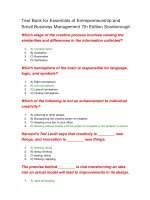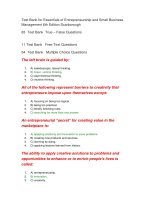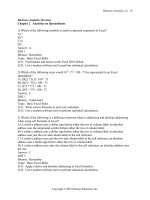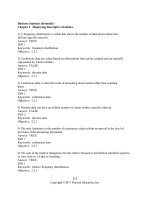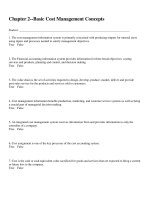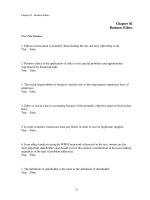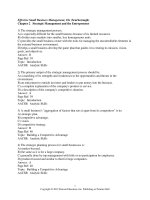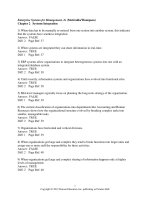Entrepreneurship and small business management 2nd edition mariotti test bank
Bạn đang xem bản rút gọn của tài liệu. Xem và tải ngay bản đầy đủ của tài liệu tại đây (292.94 KB, 11 trang )
Entrepreneurship and Small Business Management, 2e (Mariotti)
Chapter 2 Franchising
1) Franchises are governed by ________ laws and regulations.
A) State and federal
B) State
C) Federal
D) International
E) Federal and international
Answer: A
Page Ref: 43
Learning Obj.: LO 4
AACSB: Application of knowledge
2) Many fees are must be paid regardless of ________.
A) Profitability
B) Cash flow
C) Sales
D) Both A and B
E) A, B, and C
Answer: D
Page Ref: 41
Learning Obj.: LO 2
AACSB: Analytical thinking
3) Franchise operating guidelines ________.
A) Vary considerably
B) Are constant
C) Are always well defined
D) Never change
E) All of the above
Answer: A
Page Ref: 39
Learning Obj.: LO 2
AACSB: Analytical thinking
4) All of the following are a new type of franchising opportunity except ________.
A) Internet franchises
B) Conversion franchises
C) Co-branding franchises
D) Piggybacking franchises
E) Leapfrogging franchises
Answer: E
Page Ref: 43
Learning Obj.: LO 3
AACSB: Analytical thinking
1
Copyright © 2015 Pearson Education, Inc.
5) Any cost saving resulting from franchisee purchasing power helps to offset other costs, such
as franchise ________.
A) Fees
B) Accounting
C) Gains
D) Losses
E) Overhead
Answer: A
Page Ref: 38
Learning Obj.: LO 2
AACSB: Analytical thinking
6) Which of the following is not an ongoing cost of franchises?
A) Start-up fees
B) Royalties
C) Top-line revenues
D) Cooperative advertising fees
E) All of the above are ongoing costs.
Answer: A
Page Ref: 41
Learning Obj.: LO 2
AACSB: Analytical thinking
7) Franchisees may pay a fee that is separate from the royalty fee, often called a ________, to
contribute to a shared advertising fund.
A) Cooperative advertising fee
B) Cooperative franchising fee
C) Cooperative marketing fee
D) Cooperative print fee
E) Cooperative media fee
Answer: A
Page Ref: 38
Learning Obj.: LO 2
AACSB: Analytical thinking
8) The franchisor cannot require the individual franchisee to adhere to a(n) ________.
A) Pricing structure
B) Advertising agreement
C) Supplier agreement
D) Operating structure
E) Product line
Answer: A
Page Ref: 40
Learning Obj.: LO 2
AACSB: Analytical thinking
2
Copyright © 2015 Pearson Education, Inc.
9) Which of the following is true regarding the costs of franchises?
A) They vary significantly.
B) They are always expensive.
C) They are unaffordable.
D) They are outrageous.
E) They are unreasonable.
Answer: A
Page Ref: 41
Learning Obj.: LO 2
AACSB: Analytical thinking
10) Start-up standards required of franchisees may include which of the following?
A) Specific types of experience and skills
B) Net worth requirements
C) Liquidity requirements
D) All of the above
E) None of the above
Answer: D
Page Ref: 42
Learning Obj.: LO 2
AACSB: Analytical thinking
11) Which of the following is not a type of franchising according to the text?
A) Product and trade-name franchising
B) Business-format franchising
C) Inclusive franchising
D) All of the above are types of franchising.
E) None of the above is a type of franchising.
Answer: C
Page Ref: 35-36
Learning Obj.: LO 1
AACSB: Analytical thinking
12) The most significant advantage of a franchise is the increased probability of ________, given
that franchise brands have positive track records and instant recognition in most communities.
A) Success
B) Failure
C) Popularity
D) Optimism
E) Regret
Answer: A
Page Ref: 37
Learning Obj.: LO 2
AACSB: Analytical thinking
3
Copyright © 2015 Pearson Education, Inc.
13) Performing due diligence may include ________.
A) Fully understanding the FDD of the franchise company
B) Calling on existing franchisees
C) Visiting the franchise headquarters
D) Doing Internet research
E) All of the above
Answer: E
Page Ref: 47
Learning Obj.: LO 5
AACSB: Analytical thinking
14) The FDD includes information such as ________.
A) Fees and costs
B) Contractual obligations
C) Territory
D) Data regarding existing units
E) All of the above
Answer: E
Page Ref: 44
Learning Obj.: LO 4
AACSB: Application of knowledge
15) Products and services in a franchise may not be altered, added, or dropped without
________.
A) Franchisor agreement
B) Termination of the franchise
C) Penalty
D) Legal action
E) An act of God
Answer: A
Page Ref: 40
Learning Obj.: LO 2
AACSB: Analytical thinking
16) In relation to franchising advantages, you purchase the use of the company's logo, trademark,
and advertising, as well as the physical design, layout, and décor that ensure ________.
A) Recognition
B) Consistency
C) Uniformity
D) Unity
E) All of the above
Answer: A
Page Ref: 38
Learning Obj.: LO 2
AACSB: Analytical thinking
4
Copyright © 2015 Pearson Education, Inc.
17) The term "FDD" stands for which of the following?
A) Franchise Disclosure Document
B) Franchisee Disclosure Document
C) Franchisor Disclosure Document
D) Federal Disclosure Document
E) None of the above
Answer: A
Page Ref: 44
Learning Obj.: LO 4
AACSB: Analytical thinking
18) All of the following are factors of franchise cost except ________.
A) Type of franchise
B) Brand recognition
C) Popularity
D) Capacity to secure franchisees
E) Type of product
Answer: E
Page Ref: 41
Learning Obj.: LO 2
AACSB: Analytical thinking
19) Which of the following is true regarding inspections conducted by franchisors?
A) They may be announced or unannounced.
B) They are always surprise inspections.
C) Specific times must be scheduled.
D) It is unlawful to do such inspections.
E) Very few franchisors do inspections.
Answer: A
Page Ref: 42
Learning Obj.: LO 2
AACSB: Analytical thinking
20) According to the text, which of the following is not a consideration when selecting a
franchise?
A) Self-reflection
B) Research
C) Geography
D) Gender
E) Brand
Answer: D
Page Ref: 45
Learning Obj.: LO 5
AACSB: Reflective thinking
5
Copyright © 2015 Pearson Education, Inc.
21) Subway restaurants can be found ________.
A) In traditional stand-alone units
B) In convenience stores
C) In shopping malls
D) In military bases
E) All of the above
Answer: E
Page Ref: 35
Learning Obj.: LO 1
AACSB: Application of knowledge
22) Strong franchisors have all of the following except ________.
A) Established multiple franchises
B) Positive relationships with their franchisees
C) Years of experience
D) Many legal disputes
E) None of the above is an exception.
Answer: D
Page Ref: 40
Learning Obj.: LO 2
AACSB: Analytical thinking
23) In many instances, products or ingredients in a franchise must be purchased from ________.
A) The franchisor
B) Designated suppliers
C) Any suppliers
D) Both A and B
E) All of the above
Answer: D
Page Ref: 40
Learning Obj.: LO 2
AACSB: Analytical thinking
24) Which of the following aspects would the franchisor control in a business-format franchising
situation?
A) Accounting
B) Marketing
C) Operations
D) Quality assurance
E) All of the above
Answer: E
Page Ref: 36
Learning Obj.: LO 1
AACSB: Analytical thinking
6
Copyright © 2015 Pearson Education, Inc.
25) The formula provided by the franchise does which of the following?
A) Guarantees brand recognition
B) Eases the issues of start-up development
C) Ensures ongoing support
D) Removes the creativity and freedom
E) All of the above
Answer: E
Page Ref: 37
Learning Obj.: LO 2
AACSB: Reflective thinking
26) Franchisors are ________ to provide operating manuals and training to their franchisees,
which are a valuable resource for success.
A) Required
B) Not required
C) Encouraged
D) Unable
E) None of the above
Answer: A
Page Ref: 39
Learning Obj.: LO 2
AACSB: Analytical thinking
27) Franchisors are focused on creating wealth for ________.
A) Themselves
B) Friends
C) Franchisees
D) The community
E) Employees
Answer: A
Page Ref: 41
Learning Obj.: LO 2
AACSB: Analytical thinking
28) A franchisor's record of success can ________.
A) Provide a significant advantage for your business start-up
B) Be a concern for a franchisee
C) Never provide help for start-up
D) Be proven
E) Not be counted on
Answer: A
Page Ref: 40
Learning Obj.: LO 2
AACSB: Analytical thinking
7
Copyright © 2015 Pearson Education, Inc.
29) All of the following are advantages of franchising except ________.
A) Training
B) Financing assistance
C) Purchasing power
D) Promotional support
E) Loss of control
Answer: E
Page Ref: 37
Learning Obj.: LO 2
AACSB: Analytical thinking
30) All of the following are selected franchise fees and costs according to the text, except
________.
A) Training
B) Advertising and promotion
C) Fixtures
D) Initial inventory
E) Local publicity campaigns
Answer: E
Page Ref: 41
Learning Obj.: LO 2
AACSB: Analytical thinking
31) The franchisor is the second party to the franchise agreement and is the owner of the unit or
territory rights.
Answer: FALSE
Page Ref: 35
Learning Obj.: LO 1
AACSB: Analytical thinking
32) Sound franchisors provide a significant quantity and excellent quality of start-up assistance
to new franchisees, as well as ongoing education and support for established ones.
Answer: TRUE
Page Ref: 37
Learning Obj.: LO 2
AACSB: Application of knowledge
33) As a franchisee you will benefit from the purchasing power of the franchisor to get lower
costs and improved vendor service.
Answer: TRUE
Page Ref: 38
Learning Obj.: LO 2
AACSB: Application of knowledge
8
Copyright © 2015 Pearson Education, Inc.
34) If you are looking to start a business that is creative and is not controlled by others, then
franchising is your best option.
Answer: FALSE
Page Ref: 40
Learning Obj.: LO 2
AACSB: Analytical thinking
35) McDonalds is the only franchise available for ownership internationally.
Answer: FALSE
Page Ref: 48
Learning Obj.: LO 6
AACSB: Application of knowledge
36) Product and trade-name franchising is the licensing of the product or the production of the
product and the use of the trademark, logo, or other identity of the franchise.
Answer: TRUE
Page Ref: 36
Learning Obj.: LO 1
AACSB: Reflective thinking
37) There is no need for legal representation when entering into a franchise agreement.
Answer: FALSE
Page Ref: 45
Learning Obj.: LO 4
AACSB: Analytical thinking
38) Master franchises do not allow individuals and organizations to buy the right to subfranchise
within a delineated geographic territory.
Answer: FALSE
Page Ref: 36
Learning Obj.: LO 1
AACSB: Application of knowledge
39) There are few resources for franchise research.
Answer: FALSE
Page Ref: 46
Learning Obj.: LO 5
AACSB: Analytical thinking
40) It is uncommon for a franchisor to handle the national and regional media purchasing for a
franchisee.
Answer: FALSE
Page Ref: 38
Learning Obj.: LO 2
AACSB: Reflective thinking
9
Copyright © 2015 Pearson Education, Inc.
41) Franchisees may pay a fee that is separate from the royalty fee, often called a cooperative
advertising fee, to contribute to an individual advertising fund.
Answer: FALSE
Page Ref: 38
Learning Obj.: LO 2
AACSB: Analytical thinking
42) A franchise is a business that markets a product or service developed by a franchisor,
typically in the manner specified by the franchisor.
Answer: TRUE
Page Ref: 35
Learning Obj.: LO 1
AACSB: Analytical thinking
43) The start-up and ongoing assistance provided by a franchisor guarantees your success.
Answer: FALSE
Page Ref: 40
Learning Obj.: LO 2
AACSB: Analytical thinking
44) The most significant advantage for a franchisee is the increased probability of success.
Answer: TRUE
Page Ref: 37
Learning Obj.: LO 2
AACSB: Analytical thinking
45) The costs of franchises vary significantly.
Answer: TRUE
Page Ref: 41
Learning Obj.: LO 2
AACSB: Analytical thinking
46) Apply the steps of franchise selection to your business idea. Identify the most critical steps
for your situation and how these issues would help you determine the best franchise opportunity.
Answer: Student responses will vary but the eleven steps indicated — from self-reflection and
engagement of core supporters to making it work — are important in evaluating the franchise
opportunity.
Page Ref: 45-47
Learning Obj.: LO 5
AACSB: Reflective thinking
10
Copyright © 2015 Pearson Education, Inc.
47) If you were to become a franchisee, which type of franchise would you choose? Discuss
possible concerns and advantages of different franchise types.
Answer: Answers will vary. Aspects of answers should include issues of control, possible
advantages of franchisor involvement, expectations of franchisors, and freedom of the
franchisee.
Page Ref: 35-36
Learning Obj.: LO 1
AACSB: Analytical thinking
48) What franchising issues would you need legal assistance to address? How would that affect
your decision to franchise or not to franchise?
Answer: Franchises are governed by state and federal laws and regulations. The Franchise
Disclosure Document (FDD) is the primary source of information regarding the disclosures to be
made by franchisors. Since the agreement between a franchisor and a franchisee is a legal
agreement, a franchise would need legal assistance. Student responses could vary in terms of
whether this would affect their decision to franchise or not.
Page Ref: 43-44
Learning Obj.: LO 4
AACSB: Reflective thinking
49) What are some of the positive aspects of franchises that could assist you with your business
idea? What advantages could you utilize in start-up, operations, competitive advantage, and so
on?
Answer: The section "Positive Aspects of Franchises" indicates various reasons why one would
become a franchisee: start-up assistance, instant recognition, purchasing power, advertising and
promotional support, operating guidelines and assistance, and track record of success.
Page Ref: 37-40
Learning Obj.: LO 2
AACSB: Analytical thinking
50) What are some of the key drawbacks of buying a franchise? How could these issues hinder
your business?
Answer: The section "Drawbacks of Buying a Franchise" identifies factors such as constraints
on creativity and freedom, costs, and standards and termination as the key disadvantages for a
potential franchisee. Student responses will differ with regards to whether these drawbacks
would hinder or help the franchise.
Page Ref: 40-42
Learning Obj.: LO 2
AACSB: Reflective thinking
11
Copyright © 2015 Pearson Education, Inc.
